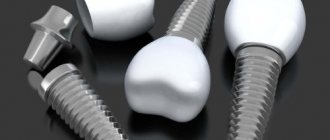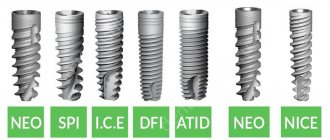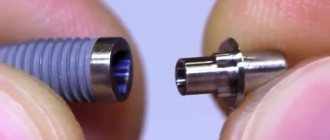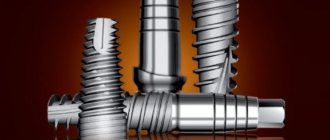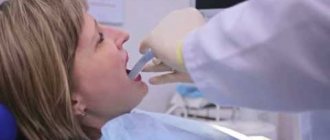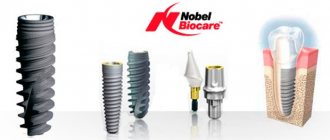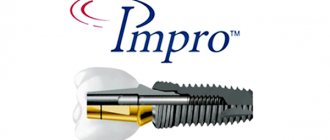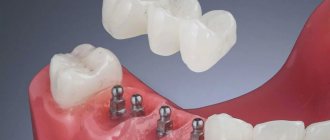From this article you will learn:
- Alpha Bio Israel implants – reviews from implantologists,
- their characteristics, pros and cons,
- turnkey price with crown (for 2022).
Alpha-bio implants are a line of economy class dental implants from Israel. It should be noted that the implants of this company occupy the second place in popularity in Israel itself - after the also Israeli ]MIS[/anchor]. As you will see below, choosing Alpha-Bio implants can only be optimal if you have a goal to fit within a small budget. Installation of 1 such implant with prosthetics will cost only 35,000 rubles.
The integration of implants into bone depends primarily on the characteristics of their surface. Alpha-Bio implants can give good results in relatively simple situations, for example, when choosing a two-stage implantation technique (which means prosthetics 3-6 months after surgery), as well as provided there is sufficient bone volume in the implantation area. The optimal area, in our opinion, would be the area of the lateral chewing teeth, where ideal aesthetics of the gums around the neck of the dental implant are not required. We will explain why we think so below.
Alpha-bio implant line: photo
Alpha bio implants will not be the optimal choice if they are installed in an area with insufficient bone volume (especially if we are talking about the area of the front teeth). They are not very suitable for immediate and early loading of implants, i.e. when prosthetics are performed either immediately after surgery or in the first 2-6 weeks after it. But if your goal is to install 1-2 implants on a budget, in order to at least avoid grinding down adjacent teeth for crowns, then this may be your option.
An interesting fact: since 2008 it has belonged to the Swiss company, which is one of the world leaders in the production of implants in dentistry - along with such companies as Straumann (Switzerland) and AstraTech (Sweden). However, thanks to this merger with the leader in the implant market, AlfaBio implants have not become any better, technologically remaining at the 2000 level. There is a reason for the latter, which we will discuss below.
Surface characteristics of Alpha-Bio implants –
There are 2 main characteristics of implants, which primarily affect the quality and degree of osseointegration, i.e. on the quality of fusion of the implant with the bone. First of all, these are the surface features of the dental implant, and to a lesser extent, its shape (cylindrical or conical), and the thread features.
1) Material of manufacture –
The manufacturer uses titanium alloy Ti-6Al-4V (titanium - 6 aluminum - 4 vanadium) class 23. This is the most popular titanium alloy among manufacturers of economy class implants. On the one hand, aluminum and vanadium impurities make it possible to slightly increase the strength of titanium, but on the other hand, they somewhat worsen the speed and degree of osseointegration of implants.
It must be said that most of the top manufacturers of implants, which are rightfully market leaders in Europe and the USA, usually use a more expensive grade of titanium, for example, ultra-pure commercial grade 4 titanium (G4Ti). This grade of titanium, in turn, no longer contains impurities of vanadium and aluminum, and implants are made from it by such well-known companies as -
- Staumann (Switzerland),
- NobelBiocare (Switzerland),
- AstraTech (Sweden),
- as well as Korean ]Osstem[/anchor].
2) Surface characteristics –
The surface of this company’s implants is called “NanoTec”. According to the international classification, it is an “SLA” type surface, i.e. The implants are first sandblasted (in this case with aluminum oxide particles) and then acid etched. SLA is a quite good type of surface, but still it is the last century - in comparison with the more modern ultra-hydrophilic surfaces of implants from Strauman, Nobel and other companies.
NanoTec surface under a microscope –
This surface lacks the latest innovations and developments in the field of implantology - a negatively charged hydrophilic surface, impregnation with calcium phosphate, phosphorus or fluorine ions, and the surface nanotexturing technique is not used. All these technologies are used in more expensive implants, and they make it possible to increase the quality and speed of osseointegration, achieve good aesthetics of the gums around the implant neck, significantly speed up the start of the prosthetic stage, and also reduce the risk of implant rejection in smokers, patients with diabetes and osteoporosis.
In addition, the same “SLA” surface from different manufacturers is not at all the same. The technological features of the sandblasting process and the process of etching the surface of the implant with acid play an important role. For example, there are more expensive technologies, and there are cheaper ones. For example, sandblasting with titanium oxide particles (used by Strauman) is a fairly expensive technology and, of course, it significantly increases the cost of implants, which manufacturers of budget products cannot do.
The Straumann company (Switzerland) has implants not only with the ultra-hydrophilic “SLActive” surface, but also has more budget-friendly implant options - with the usual non-hydrophilic “SLA” surface. But you must understand that the “SLA” surface of Straumann and Alpha-Bio are 2 completely different SLA surfaces when it comes to technology and quality of osseointegration. This is exactly the option when price really matters.
AB Dental – Israeli quality mark
Implants manufactured by AB Dental Devices have been produced for more than 20 years. These solutions help implement a range of implantation protocols for patients with any diagnosis. A series of artificial roots successfully undergo international certification, and most importantly, they demonstrate positive osseointegration statistics in different patients. There is an opinion that it is best to place Israeli Dental implants immediately after removing your teeth. Thus, the procedure is almost atraumatic, the patient does not spend money on building up bone material, thereby saving time on healing and money on restoring a smile.
Israeli AB Dental implants are made of biocompatible medical titanium with a special rough coating. The pride of the company is one- and two-element roots with a hexagon inside and pronounced carvings. Such implants reliably and relatively quickly take root in the bone and are suitable for both classical two-stage and one-stage implantation.
The most popular groups of implants from the AB Dental range:
- 6-sided conical shape with pronounced thread - I5;
- cylindrical root with a hexagon inside – I2;
- I6B – ultra-thin root;
- I6 – traditional thin pin, etc.
Experts highlight a number of advantages of Israeli AB Dental pins:
- comfort for the surgeon – such systems are convenient to work with and ensure easy installation in the required position;
- stable position due to pronounced thread;
- roots can be implanted into even the densest or, on the contrary, porous bone;
- the prospect of immediate loading - ready-made solutions for express implantation.
The average price of Israeli Dental implants is about 20 thousand rubles.
Characteristics of each implant model –
For 2022, the company produces 8 variants of implants (Fig. 1). Implants NEO1, SPI, ISE, DFI, ATID – refer to the system of implants with an internal hexagon. Implant options NEO2 and NICE - refer to an implant system with a conical hexagonal connection, and are used for narrow alveolar process (in conditions of bone deficiency). ARROW implants are used for prosthetics of all lower incisors, as well as upper lateral incisors.
Alpha bio implants (basic information): animation
Now more details about each of the implants...
Implant NEO1 –
NEO1 (Fig. 2) is a classic implant for any type of bone tissue that can be used on both the upper and lower jaw.
In addition to the main thread, it has 2 microthreads, which, together with the microporous surface of the implant, significantly increase the area of contact between the implant and the bone, improving fusion. The advantage of this implant is that it can be used to create highly aesthetic restorations made of metal-free ceramics (CAD/CAM milling technology), i.e. produce individual abutments and crowns from zirconium dioxide of very high quality. This is the most expensive implant model in the AlfaBio line.
SPI implant –
The Alpha-bio “SPI” implant is used for implantation in bone tissue of types D3 and D4, i.e. in soft types of bone, which is characteristic of the upper jaw. It has good compaction characteristics of the bone surrounding the implant (when it is screwed in), which ensures high primary stability of the implant in the bone bed immediately after surgery. The manufacturer recommends it also for immediate loading with an artificial crown, i.e. immediately after surgery.
ICE implant –
ICE (Fig. 4) is a universal implant for any type of bone (both hard and soft), which the manufacturer recommends for use both in the classical two-stage implantation method and for single-stage implantation with immediate loading. But as we said above, we are skeptical about the use of Alpha-Bio implants for immediate loading.
DFI implant –
DFI (Fig. 5) is a universal implant that is used for installation specifically in denser bone types D1 and D2. It provides excellent primary stability of the implant immediately after surgery, but it is recommended to use it only for a two-stage implantation technique (i.e., 3 to 6 months will have to pass before prosthetics).
ATID implant –
The ATID implant is used for implantation in the densest bone type D1, which is the least vascularized, i.e. it has the fewest blood vessels. This type of implant minimizes pressure on dense bone, which is why ATID is used in bone type D1 (but also D2). ATID also requires a healing period of 3 to 6 months before prosthetic replacement.
The following 3 types of implants (NEO2, NICE and ARROW) are used for narrow alveolar process in conditions of bone deficiency, as well as insufficient space for prosthetic restoration.
NEO2 implant –
NEO2 (Fig. 7) is a new generation of spiral implants, and is intended for implantation in small surgical or orthopedic spaces. In addition, NEO2 has the possibility of the most aesthetic type of prosthetics, i.e. here it is possible to manufacture individual abutments and crowns using CAD/CAM technology from metal-free ceramics (i.e., zirconium dioxide).
NICE implant –
NICE (Fig. 8) is a really thin implant for very narrow alveolar ridges of the jaws, which is also used in limited spaces (when there are tooth roots or other implants nearby). The NICE implant has a thin conical body, apical part with sharp and deep threads combined with variable thread design and an optimal hexagonal conical connection.
ARROW implants –
This series includes 2 implants (Fig. 9). ARRP is a monolithic implant that already has a permanent abutment - intended for use in narrow alveolar ridges, mainly for prosthetics of the upper lateral and all lower incisors (implantation with immediate loading).
The ARRC implant is very similar to the previous one, but without a permanent abutment. Thanks to the possibility of choosing different types of abutments, prosthetics are possible in different clinical situations. On the manufacturer's website you can also find detailed information on Alpha bio implants: the official website is https://alphabio.ru, although the site is intended only for specialists.
Stages
To implement the AbDentalDevices implant, the following steps must be followed:
- initial inspection, preparation, cleaning or sanitation if necessary;
- administration of local anesthesia;
- making an incision in the mucosa, forming a bed for installing an implant;
- screwing in the rod, suturing;
- providing the Patient with recommendations for wound care.
The procedure may vary depending on the chosen treatment protocol. With single-stage implantation, after screwing in the artificial root, a temporary prosthesis is immediately attached. This is done in order to maintain aesthetics and correct load on the tissue.
Prices, guarantees, service life
The cost depends on a number of factors:
- condition of the oral cavity;
- the need for additional treatment, office cleaning;
- the number of missing units to be restored;
- selected type of implant structure;
- difficulty of installation, need for bone grafting;
- type of prosthesis, number of artificial teeth.
On average, prices for one implant including screwing start from 36 thousand rubles. At the same time, installation of a gum former costs an additional 4 thousand rubles, an abutment costs 8 thousand and more. The cost of crowns depends on the material and type, but most often they choose classic metal-ceramic or metal-free models for the frontal area.
The warranty period for fixing the artificial root is three years, but the warranty on the structure itself is lifetime, meaning replacement is not required. The manufacturer allows the use of various treatment protocols, including those with simultaneous loading. Complete osseointegration may take four to six months; with a two-stage protocol, the prosthesis is placed on average after six months.
About our clinic
Magenta Dental offers a wide range of restoration services and implantation to restore the beauty and functionality of the dentition. The procedures are performed by experienced specialists, using Israeli Ab Dental implants. Patients are provided with recommendations for oral care during the implantation period, and a schedule of preventive appointments is outlined.
Contacting us has the following advantages:
- services of dentists specializing in various fields of dentistry;
- an integrated approach, including diagnostics;
- comfortable reception conditions and attention to everyone;
- use of certified materials and implantation systems;
- affordable prices, guarantee for work performed;
- no queues, possibility of making an appointment by phone.
For more information about installing implants or making an appointment with doctors, leave a request on the website. You can also call us by phone from 09.00 to 21.00, we work seven days a week.
Alpha Bio implants – pros and cons
The Alpha-Bio implant system has quite a lot of strengths, but still these implants remain economy class and will not be able to give an ideal result in most clinical situations (24stoma.ru). The best implants from this company are NEO1, NEO2 and SPI. Implants of both NEO series have the ability to be fitted with metal-free ceramics made of zirconium dioxide using CAD/CAM technology.
This option of prosthetics will allow you to make not only a crown from ceramics, but also an individual ceramic abutment (which will have a better effect on the aesthetics of the gums). Another advantage is that the line includes implants for narrow spaces, for example, for a narrow alveolar ridge. Well, their main advantage is their affordable price. We will move on to calculating the turnkey price below.
Installation of the Alpha-Bio implant: video
In this video you can see the installation of 2 Alpha-Bio implants of the “NEO” series - in the area of the lateral upper jaw (the diameter of both implants is 3.75 mm).
Disadvantages of the AlfaBio implant system –
1) The disadvantages include the “Nano Tec” surface itself. This is certainly a high-quality SLA surface with microporosity from 1 to 5 microns, which will give a good result when using a two-stage implantation technique and in the absence of a deficiency of bone volume at the implantation site (especially when it comes to implantation in the area of lateral teeth). But as we said above, this surface is still morally outdated in comparison with more modern ultra-hydrophilic surfaces from other manufacturers.
In particular, the lack of increased hydrophilicity makes these implants less attractive in the following situations - 1) if you are planning immediate and early loading, 2) if you are planning a one-stage implantation technique, 3) if there is a deficiency of bone tissue in the implantation area and one-stage bone grafting is necessary plastic surgery, 4) and even more so if you are planning to implant a front tooth in an area with a deficiency of bone volume.
In the latter situation, you should not save on implants at all, because the surface of the implant significantly affects the efficiency of new bone formation around it. And here we need a surface with increased hydrophilicity and a special type of thread around the neck of the implant. As a practitioner, I can say that no implant behaves as well in conditions of insufficient bone volume as Straumann implants with the SLActive surface. Near these implants, bone formation is observed even in gaping type bone defects.
2) The second disadvantage is that AlfaBio implants are made of grade 23 titanium, i.e. made of titanium alloy Ti-6Al-4V. Aluminum and vanadium impurities somewhat worsen the quality and speed of osseointegration. This may be critical if you are planning immediate or early weight-bearing, if you have osteoporosis, diabetes or a smoker, or if you are using a one-stage implant technique. Again, what does the word “critical” mean? Critical in this case means that the risk of implant failure in such situations will be slightly higher - in comparison with implants made from a more expensive brand of titanium without impurities, and even more so if they also have an ultra-hydrophilic surface.
3) Around any implant, after an artificial crown is fixed on it, atrophy of the bone tissue around the neck begins. This is due to the fact that the implant begins to experience chewing load, and it is transferred from the implant to the bone. Moreover, the size of such atrophy is completely different for different implant models. The norm is considered to be 1.0 mm of bone atrophy within 1 year (from the moment of functional load) and then 0.2 mm per year. But such indicators were considered the norm until modern implants from Staumann, NobelBiocare, and AstraTech appeared.
Around the neck of implants from the above-mentioned manufacturers, bone atrophy is practically not observed at all, which is due both to the characteristics of the surface and to the fact that the necks of these implants have a special microthread pattern. Why is it so important that there is as little atrophy as possible? The loss of bone height leads to gum recession (i.e., the level of the gums recedes). At the very beginning of this process, you may notice a loss of volume in the gingival papillae in the interdental spaces, as well as a bluish appearance of the gums around the implant neck.
Further increase in gum recession leads to exposure of the metal neck of the implant. We want to note that the main complaints of patients about the dental implantation procedure in principle - in 95% of all cases - relate specifically to the poor aesthetics of the gums around the neck of the implant. Therefore, if you are planning implantation in the area of the front teeth, as well as in an area with insufficient bone volume, then as an implantologist, I would not recommend Alfa-Bio to my patients. Below in Fig. 17-24 you can see the result of installing the Alpha-bio implant with simultaneous bone grafting, and this result is not very good (we will comment on it below)
4) And we forgot one more important point - never do implantation according to the All-on-4 (or All-on-6) protocol, which are used for permanent bridge prosthetics of an edentulous jaw - using Alpha Bio implants. These implants are not suitable at all for this type of prosthetics for toothless jaws with immediate loading. You will experience very strong bone resorption around the implants within the first few years of functional load, which will lead to early failure of the structure.
If you have a toothless jaw and you are planning budget implantation using Alpha Bio implants, the choice should be made in favor of the classic two-stage implantation method, with the implants engrafting within 3-6 months (all this time you will wear a temporary removable denture). And only after this time can a permanent fixed bridge prosthesis be made. Only in this case, the design on these implants can serve you for a long time.
When choosing Alpha-Bio may be optimal -
If you plan to carry out the safest option - a two-stage dental implantation technique, in which the implant is engrafted under a tightly sutured mucous membrane, and prosthetics will begin no earlier than in 3-6 months. At the same time, there should not be a deficit of bone tissue volume in the implantation zone, and this is absolutely good - if we are talking about implantation of the lateral group of teeth.
Or the second option is when you have a limited budget and you don’t want to grind down adjacent teeth for crowns. But in this case, you will have to sacrifice the aesthetics of the gums, although if you are planning implantation in the area of the lateral teeth, then this may not be so important.
Advantages and disadvantages
AB Dental products have the following advantages:
- several lines to solve various problems, including complex clinical cases;
- use of safe materials that do not cause allergic reactions;
- improved bone integration rates;
- the presence of double threads to increase stability when screwing in;
- ring for the strength of the connection between the artificial rod and the bone;
- cross-shaped carving to restore the beautiful edge and natural shape of the alveolar ridge;
- double platform for using different abutments;
- biological compatibility, rapid healing;
- can be installed in bone at any density level;
- correct distribution of loads.
The only downside is the higher cost, but this is fully justified by the reliability and quality of the product. In addition, the use of AB Dental implants is allowed in the following cases:
- complete edentia;
- increased level of tissue sensitivity to materials used for implantation;
- diabetes at any stage, compensated hypertension;
- inflammatory processes in the oral cavity.
When fixing products from the Israeli brand, entire units are preserved as much as possible; grinding or removal of adjacent teeth is not necessary. In addition, the use of such rods makes it possible to solve issues of displacement of other row units, bone atrophy, and bite pathologies.
Alpha Bio implants: price 2022
For 1 Alpha Bio implant - the price for installation starts from 20,000 rubles for 1 implant (this is only surgery, without the cost of a crown and abutment). This is a very affordable price when compared with the installation of premium segment implants, where the cost of the surgical stage of implantation can range from 50,000 to 70,000 rubles.
For 1 Alpha Bio implant, the turnkey price, including the appropriate type of abutment, will be:
- with a metal-ceramic crown – from 35,000 rubles,
- with a ceramic zirconium crown – from 50,000 rubles.
Prices for AB Dental Devices implants in St. Petersburg
In reviews of AB Dental Devices implants, patients write that they are satisfied with their cost and quality. Implants are comfortable and people get used to them quickly. On the website Stom-Firms.ru you will find clinics where these implants are installed.
We analyzed prices for implants from AB Dental Devices in St. Petersburg:
- On average, the cost of 1 unit is 20,000 rubles.
- There are often discounts on the brand. According to promotions, the price per tooth is less than 11,000 rubles.
- In prestigious dentistry, 1 AB Dental Devices implant costs from RUB 30,000.
- Turnkey implantation is carried out at a price of 35,000 rubles.
The cost of turnkey implantation already includes diagnostics, pain relief, consumables, implants, doctor’s work and a number of additional services. For example, some clinics include dental crowns here or offer a free sinus lift. The cost of turnkey implantation is 5-10% cheaper than paying for each service that the patient needs.
Implantation is an expensive procedure, especially if the patient has more than 2 units installed. To make it easier for patients to restore their teeth, clinics offer installment plans and loans.
List of sources for the article:
- Official website of the manufacturer and catalog ab-dent.com.
- "The role of the bacterial factor and the immune system in the process of reparative osteogenesis during dental implantation." Labis V.V., Bazikyan E.A., Kozlov I.G., “Russian Dental Journal”, 2013.
- “Basics of dental implantology.” Textbook / A. S. Ivanov. 2011.
Alpha Bio implants: reviews
On Alpha bio implants – reviews from implantologists are in most cases positive, but this should not mislead you.
This economical option is offered to patients with a limited budget, and so that the patient does not refuse implantation at all, he is not told about some of the disadvantages of this option. Of course, if we are talking about implantation in the area of the front tooth (in an area with a lack of bone volume), then it is best to choose the more expensive Straumann, Nobel-Biocare or Astra implants. And if you also have a gummy type of smile (the gums are exposed when you smile), this is generally critically important. But if implants from these manufacturers are too expensive for you, there are 2 more alternatives. For example, the Israeli company MIS also has 3 implant options with an ultra-hydrophilic surface. Another economical option may be to install the TS-III CA implant from the Korean company Osstem (this implant also has a modern surface with increased hydrophilicity), but it is best used only on the upper jaw.
But as for the implants themselves, its best products are the NEO and SPI model implants. Below we will give several examples of the use of implants of this brand in practice...
1) Clinical case – absence of 4-5 teeth. A one-stage implantation technique was performed using 1 AlphaBio implant. Based on the implant and the patient’s own 6th tooth, a metal-ceramic bridge of three crowns was installed (note that a slight cyanosis of the gums around the crown on the implant is immediately visible).
2) Clinical case - with a complete absence of teeth in the upper jaw, 6 AlfaBio implants were implanted (two-stage implantation technique), onto which a permanent metal-ceramic bridge prosthesis was fixed after 6 months.
3) Clinical case – absence of a central incisor in the upper jaw. A two-stage implantation technique was performed, complicated by a lack of bone tissue in the area of the missing tooth. In parallel with the installation of the implant, bone augmentation was carried out using bone material and a bioresorbable membrane.
Commentary on this clinical case - let's look carefully at Fig. 22... despite the bone grafting performed, we see that the alveolar process in the area of the installed implant has a large concavity. Those. the increase in bone volume occurred in insufficient volume, and here the anterior bone wall will be clearly thinner than 2 mm. Of course, this will lead to bone tissue atrophy on the front surface of the implant, gum recession, and poor aesthetics.
In principle, in Fig. 23-24 we already see that the volume of the gingival papillae is insufficient, and due to this, the interdental spaces look like dark spots (dips). Over time, this problem will only worsen and the aesthetics will become completely unacceptable. That’s why we say that Alpha-Bio implants are not a very good option in the area of the front teeth (especially if there is insufficient bone volume).
Summary:
If the protocol for the surgical stage of implantation is followed, the survival rate of Alpha Bio implants is about 96% when implanted in the upper jaw and about 98% when implanted in the lower jaw. These are good indicators, but not the best. Again, for market leading companies these figures are still 1-1.5% higher. However, as we said above, implant survival is not the only indicator that you need to pay attention to.
For example, the main reason for negative reviews of implants is the increasing deterioration of aesthetics in the gingival zone. This is due to the natural gradual atrophy of the bone around the implant neck, which can reach up to 1.5 mm only during the first 1.5 years. A decrease in the bone level leads to the fact that the neck of the implant remains covered only by the mucous membrane, which leads to the appearance of sharp blueness of the gums around the implant, as well as a decrease in the level of gingival papillae. Therefore, a very important criterion when choosing an implant in the aesthetic zone is the amount of bone atrophy during the first 5 years.
And clinical studies and the experience of implantologists can give us an idea of this. When implanting in the aesthetic zone (in the area of the front teeth), I would give preference primarily to AstraTech and Straumann implants, because these implants have the lowest rate of bone atrophy. As for the implantation technique with immediate or early loading, when prosthetics are carried out immediately or within several weeks after implantation, then it is also advisable to choose the above implants (but if the budget does not allow, then at least MIS or Osstem).

